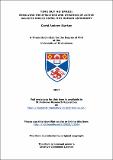Files in this item
Time but no space : resolving the structure and dynamics of active galactic nuclei using time domain astronomy
Item metadata
| dc.contributor.advisor | Horne, K. (Keith) | |
| dc.contributor.author | Starkey, David Andrew | |
| dc.coverage.spatial | xxi, 177, [6] p. | en_US |
| dc.date.accessioned | 2017-08-30T10:23:26Z | |
| dc.date.available | 2017-08-30T10:23:26Z | |
| dc.date.issued | 2017-08-01 | |
| dc.identifier | uk.bl.ethos.722983 | |
| dc.identifier.uri | https://hdl.handle.net/10023/11564 | |
| dc.description.abstract | This thesis presents a study of the sub-light year regions of Active Galactic Nuclei (AGN). These environments contain accretion discs that orbit a central super-massive black hole. The luminosity of the AGN inner regions varies over time across all wavelengths with variability at longer wavelengths lagging behind that at shorter wavelengths. Since the AGN themselves are too remote and too compact to resolve directly, I exploit these time lags to infer the physical characteristics of the accretion disc and surrounding gas clouds that emit broad emission lines. These characteristics include the inclination and temperature profile of the accretion disc, and the shape (or light curve) of the luminosity fluctuations that drive the accretion disc variability. This thesis details the work in the first author papers of Starkey et al. (2016, 2017), in which I detail the statistical code, CREAM (Continuum REverberting AGN Markov Chain Monte Carlo), that I developed to analyse AGN accretion disc variability. I apply the code to a set of AGN light curve observations of the Seyfert 1 galaxy NGC 5548 by the AGN STORM collaboration (De Rosa et al., 2015; Edelson et al., 2015; Fausnaugh et al., 2016a; Goad et al., 2016; Starkey et al., 2017). I also present work detailing my variability analysis of the Seyfert galaxies NGC 6814, NGC 2617, MCG 08-11-11 and NGC 4151. This work has contributed to the analysis presented in (Troyer et al. 2016, Fausnaugh et al. submitted). I also investigate the implications of a twin accretion disc structure (Nealon et al., 2015) on the disc time lag measurements across near UV and optical wavelengths. I finish by detailing a modification to CREAM that allows it to merge continuum light curves observed in a common filter, but taken by multiple telescopes with different calibration and instrumental effects to consider. | en_US |
| dc.language.iso | en | en_US |
| dc.publisher | University of St Andrews | |
| dc.rights | Attribution-NonCommercial 4.0 International | * |
| dc.rights.uri | http://creativecommons.org/licenses/by-nc/4.0/ | * |
| dc.subject.lcc | QB858.3S8 | |
| dc.subject.lcsh | Active galactic nuclei | en |
| dc.subject.lcsh | Active galactic nuclei--Spectra | en |
| dc.subject.lcsh | Protoplanetary disks | en |
| dc.subject.lcsh | Galactic dynamics | en |
| dc.subject.lcsh | Time domain analysis | en |
| dc.title | Time but no space : resolving the structure and dynamics of active galactic nuclei using time domain astronomy | en_US |
| dc.type | Thesis | en_US |
| dc.type.qualificationlevel | Doctoral | en_US |
| dc.type.qualificationname | PhD Doctor of Philosophy | en_US |
| dc.publisher.institution | The University of St Andrews | en_US |
The following licence files are associated with this item:
This item appears in the following Collection(s)
Except where otherwise noted within the work, this item's licence for re-use is described as Attribution-NonCommercial 4.0 International
Items in the St Andrews Research Repository are protected by copyright, with all rights reserved, unless otherwise indicated.


